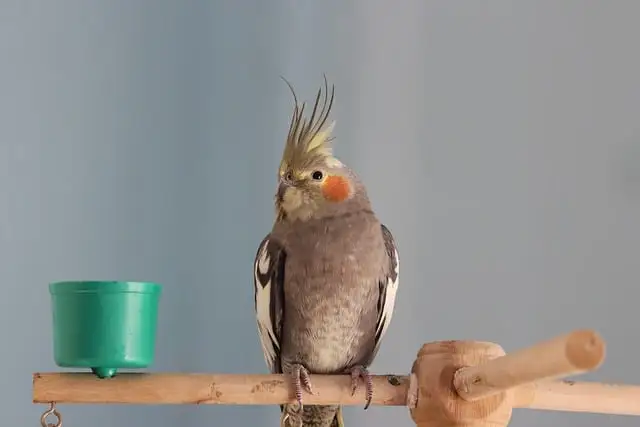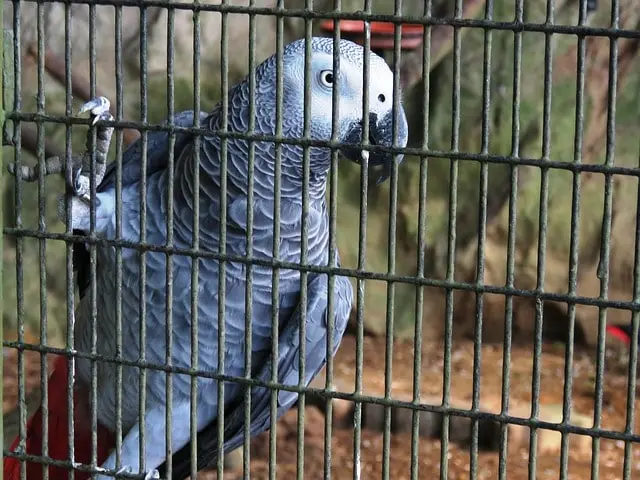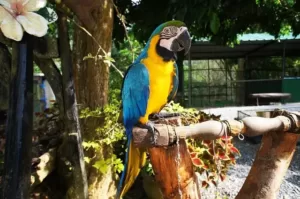The ideal weight for a parrot depends on its species and age. Because parrots are such energetic creatures, some fluctuations in weight can be attributed to their activity levels. However, if your parrot’s eating a healthy diet, its weight should not veer too far off the ideal weight range.
Both an increase and decrease in weight can raise concerns about your parrot’s health, especially if the changes occur in a short period of time. This is why weighing your parrot on a regular basis is so crucial to track your bird’s health.
Quick Navigation
The Importance Of Weighing Your Parrot Regularly
Keeping a log of your parrot’s weight can help you stay informed about its overall health and also potentially save a ton on vet bills. Parrots have a tendency to hide their illnesses because in the wild, showing any sign of weakness invites predators.
This survival instinct is hardwired in the parrot’s brain and they can go to great lengths to conceal their weakness. From the outside, you may not be able to tell whether your parrot is sick until the condition has progressed significantly.
This is why we need to look at other ways to assess our bird’s health. The two most common ways include checking your parrot’s poop for changes and keeping a weight journal.
A drastic change in your parrot’s weight can be the very first sign of illness. Parrots that are sick lose weight slowly, to the point where they start looking skinny and emaciated. It is often hard to tell by a look because the fluff of the feathers can make parrots look full even when they’re losing weight continuously.
However, too much weight gain is also not the best thing for your parrot and often indicates a problem with their diet. Parrots can get fat when you do not provide them with a nutritionally balanced diet or feed them too many unhealthy snacks.
Parrots that do not get a sufficient amount of nutrients from their diet tend to overeat, which can also lead to weight gain. So when you monitor your bird’s weight, it helps you see the changes and make adjustments in their diet accordingly.

What Is The Average Weight Of A Parrot?
Below is a table of the average weight of different species of parrots and their subspecies. The following data is according to World Parrot Trust.
| Parrot Species | Subspecies | Average Weight (Grams) |
|---|---|---|
African Greys | Congo African Grey | 400 g |
| Timneh African Grey | 320 g | |
Macaws | Scarlet Macaw | 1060-1123 g |
| Blue and Gold Macaw | 1040-1286 g | |
| Green-winged Macaw | 1050-1320 g | |
| Hahn’s Macaw | 1200-1400 g | |
| Hyacinth Macaw | 1200-1450 g | |
| Red-Fronted Macaw | 525-550 g | |
| Blue-Throated Macaw | 750 g | |
Cockatoos | Galah | 270-400 g |
| Goffin’s Cockatoo | 300 g | |
| Yellow-Crested Cockatoo | 308-380 g | |
| Greater Sulphur-Crested Cockatoo | 815-975 g | |
| Moluccan Cockatoo | 775-935 g | |
| Palm Cockatoo | 910-1200 g | |
| Umbrella Cockatoo | 300–1200 g | |
Amazon Parrots | Blue-Fronted Amazon Parrots | 375-450 g |
| Red Lored Amazon Parrots | 314-485 g | |
| Yellow-Naped Amazon Parrots | 480-550 g | |
| Double Yellow-Headed Amazon Parrots | 400-650 g | |
| Lilac-Crowned Amazon Parrots | 325 g | |
| Green Cheeked Amazon Parrots | 293-345 g | |
| Orange-Winged Amazon Parrots | 298-470 g | |
Conures | Green-Cheeked Conure | 60-80 g |
| Jenday Conure | 60-80 g | |
| Nanday Conure | 140 g | |
| Orange-Fronted Conure | 68 to 80 g | |
| Sun Conure | 120-130 g | |
| Patagonian Conure | 256-281 g | |
| Dusky-Headed Conure | 95-115 g | |
Lovebirds | Fischer’s Lovebird | 42-58 g |
| Black-Masked Lovebird | 43-50g | |
| Peach-Faced Lovebird | 46-63g | |
Lorikeets | Rainbow Lorikeets | 100-157g |
| Blue Streaked Lory | 155-165 g | |
| Chattering Lory | 180-220 g | |
| Red Lory | 168-172 g | |
| Dusky Lory | 150-160 g | |
Caiques | Black-Headed Caique | 145-170 g |
| White-Bellied Caique | 160-170 g | |
Other Parrot Species | Cockatiels | 72-108 g |
| Quaker Parrot | 127-140 g | |
| Pionus Parrot | 179-222 g | |
| Senegal Parrot | 155 g | |
| Eclectus Parrot | 450-600 g |
How To Weigh A Parrot?
To weigh your parrot, you can use a bird scale, though a regular gram scale will also be just fine. You should do this in the morning when your parrot is on an empty stomach to get a base weight. The process of weighing is quite straightforward; you place your parrot on the scale and wait for the reading.
However, there are a few things to keep in mind to get the most accurate read. When weighing your parrot you should always use a gram scale for the most accurate results. Most parrots weigh under a kilogram which makes grams the ideal measurement.
Weighing your parrot in grams is more precise than pounds and can help you track the subtle fluctuations in weight. If you’re using pounds, you’re going to miss the nuances especially when your parrot is a smaller species.
Also, while weighing your parrot offer it some treats so that it stays on the scale longer without moving too much. Offer a small treat like a seed, so that your parrot does not have to lift its leg to grasp it.

How Often Should You Weigh Your Parrot?
It is ideal to weigh your parrot on a weekly basis. More importantly, though, you should keep a journal of the different weights and review it at the end of every month.
Small changes within a couple of weeks period may be enough to draw any conclusions, so it is a good idea to look at the numbers over a longer period.
Your parrot’s weight should not fluctuate more than a few grams each time you weigh them. If your parrot loses weight by 2-3 percent, it can be a cause for concern.
How To Use The Keel Score Chart?
The keel score is an alternate method to check whether your parrot is within the healthy weight range without a scale. Vets often use this method to check whether a parrot is underweight or overweight.
It is a quick assessment that can tell you the parrot’s body condition. However, it is not the best technique for monitoring your parrot’s weight generally.
To perform this test, you simply need to touch your parrot’s keel bone and score it based on how sharp it felt. The keel bone is located at the center of a parrot’s chest.
If the breastbone feels sharp to the touch, it means your parrot is underweight. Similarly, if it is buried under a layer of fat, it indicates that your parrot needs to lose weight.







